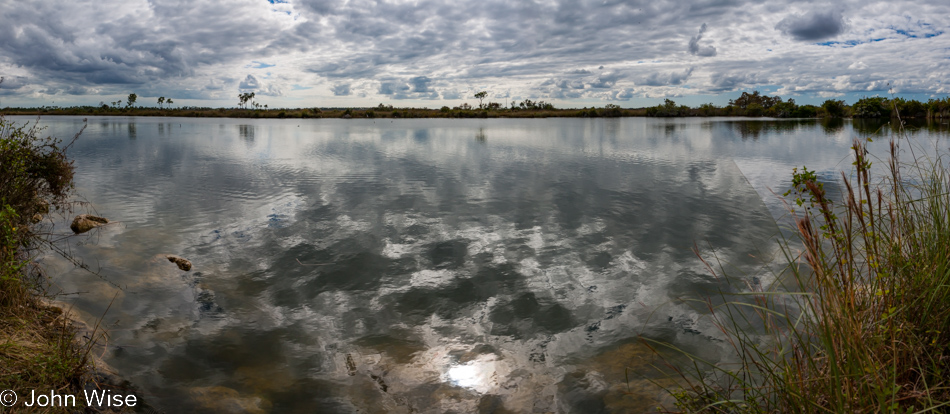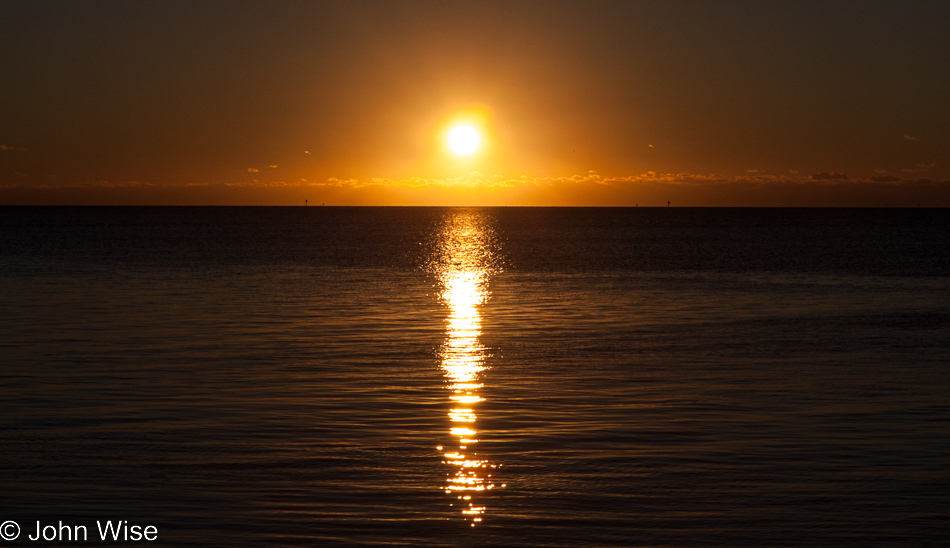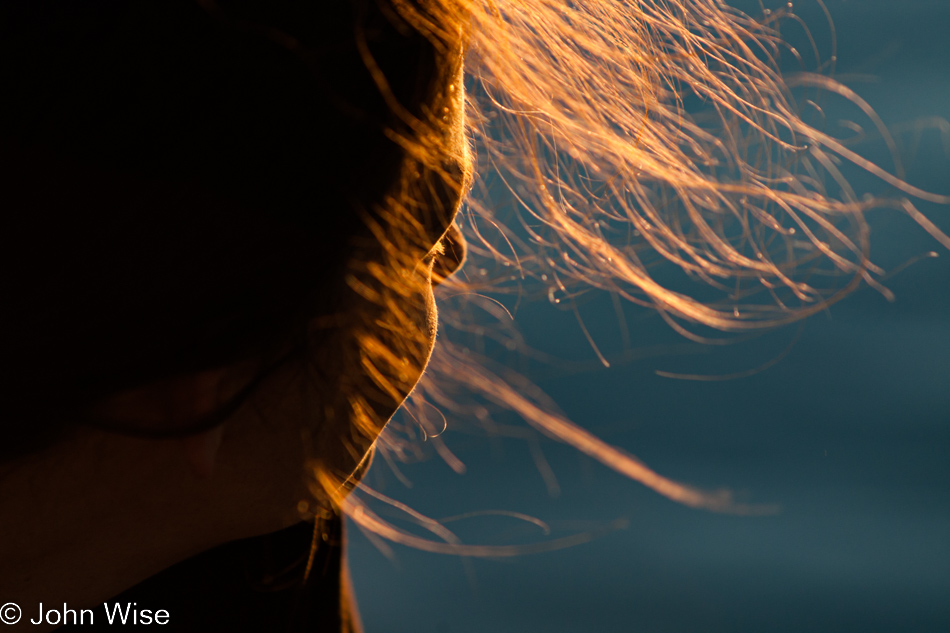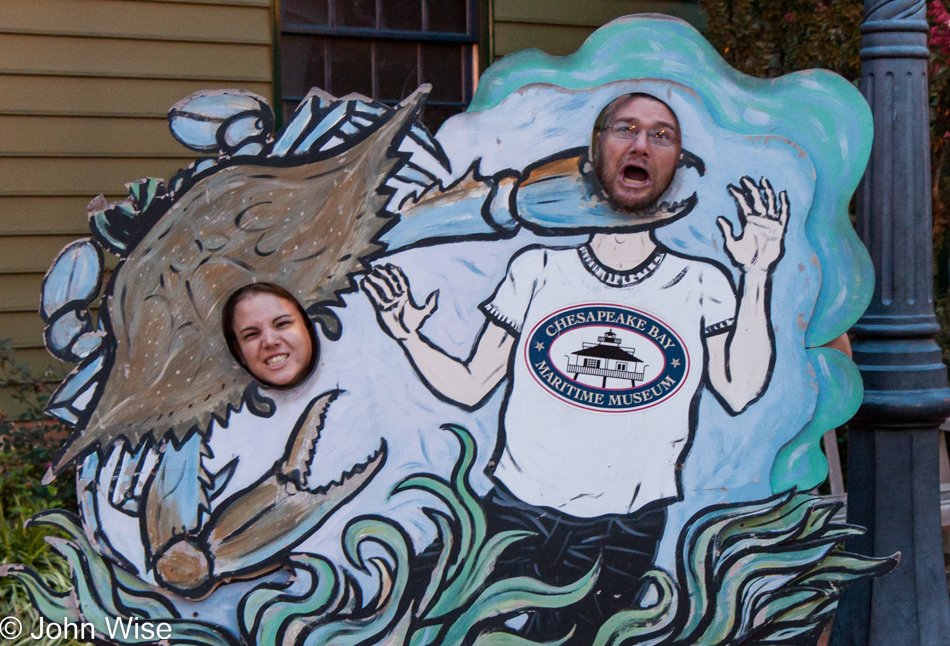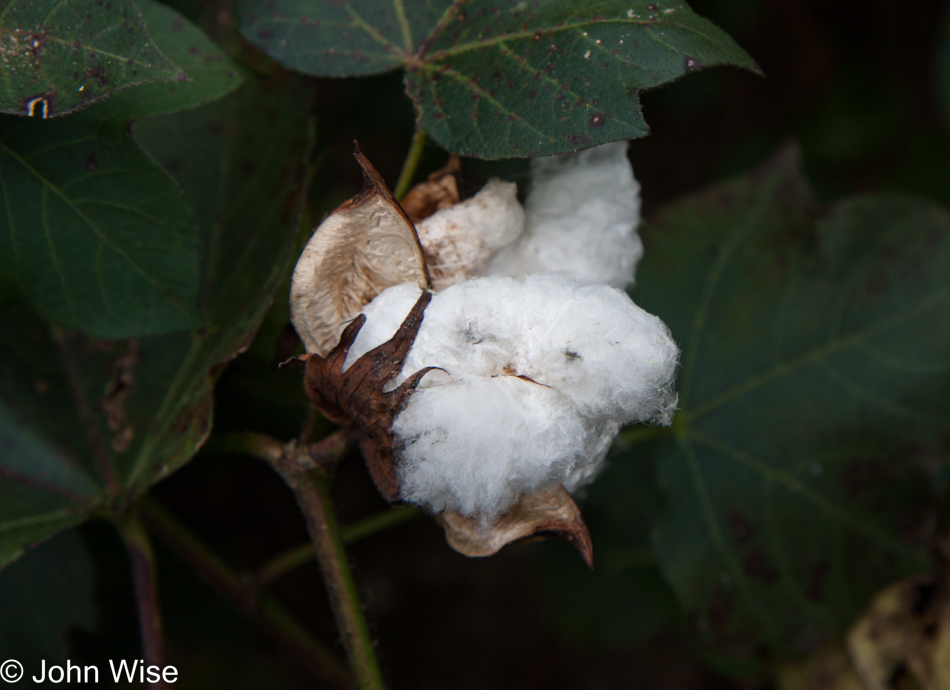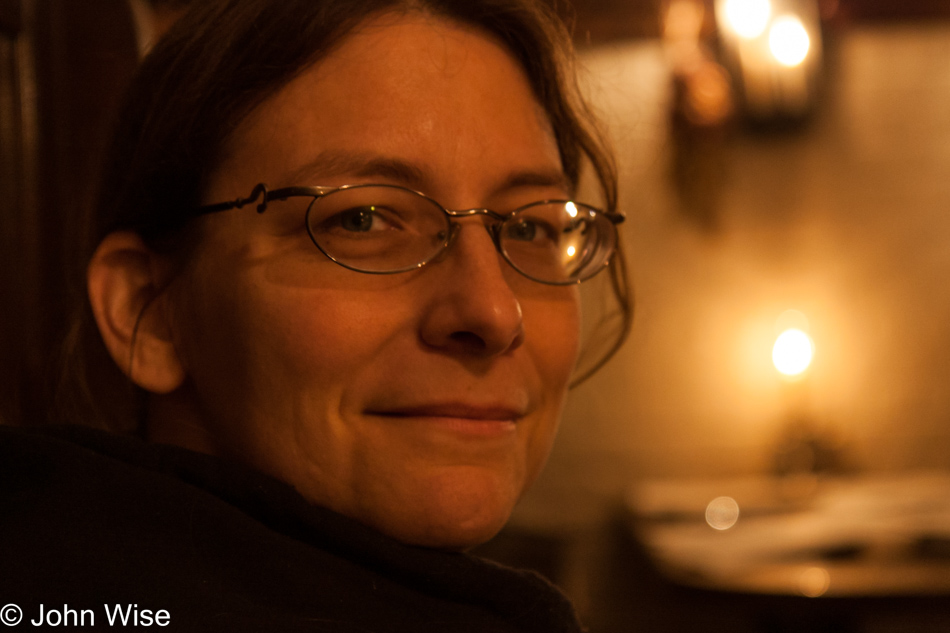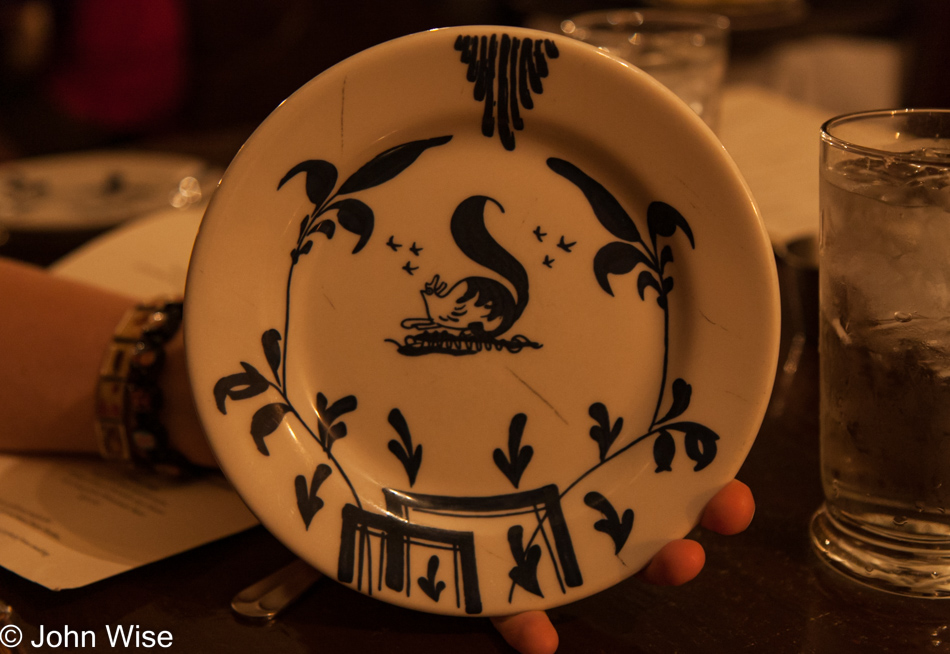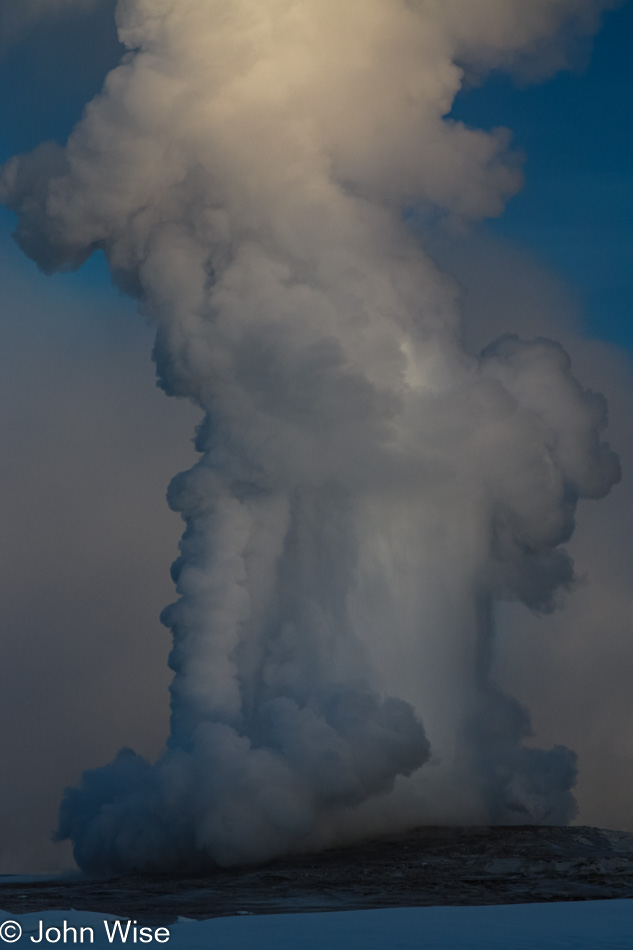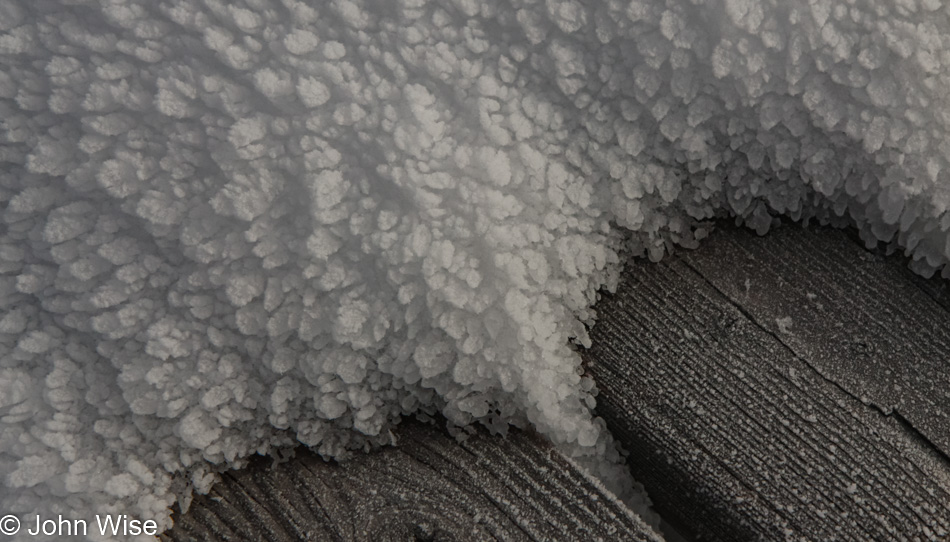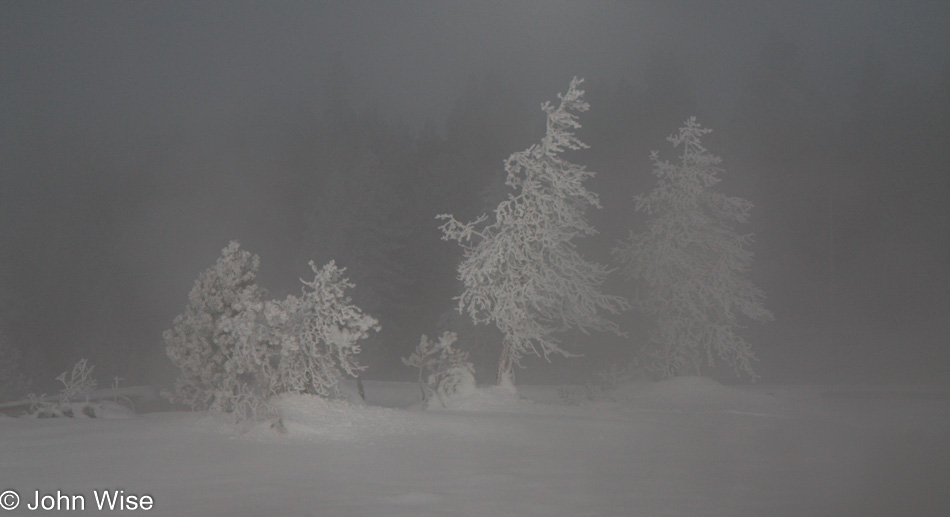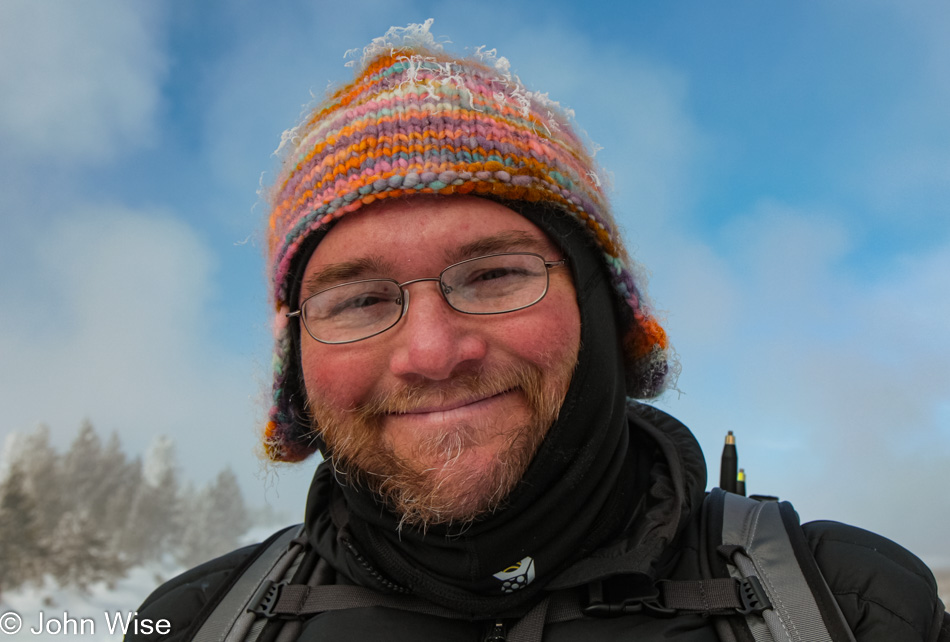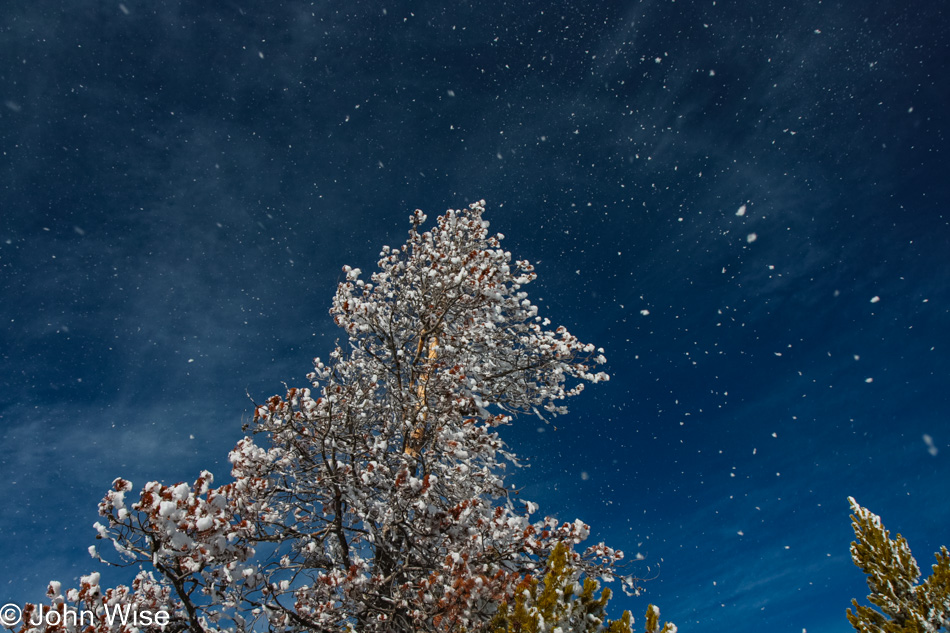
Serendipity often plays its part during our travels. A series of events or circumstances line up with results that initially are not always appreciated. Hours later, when recognizing how perfectly the day unfolded, we’ll see that had those things not occurred as they did, we wouldn’t have been in the right place at the right time. Today, for example, we had to return to our room after breakfast to grab a couple of items prior to hitting the trail. It was still twilight, and as I looked out the window, the scene demanded I take a photo. Upon viewing it, I see that the camera sensor is as dirty as it can be – frustration ensues. I’ve brought nothing to clean a dirty sensor, and auto clean is failing. The squeeze bulb used to shoot a puff of air to dislodge light fuzz is not budging these glued-on specks, what to do?

We had originally planned to tour the boardwalk on the terraces of Mammoth Hot Springs for sunrise. Sunrise has come and gone. Finally, a silk sock liner comes to the rescue with a drop or two of contact lens fluid and does a more or less adequate job of cleaning the sensor. Now late, much later than expected we finally leave the room and make our way to the ski shop to check our options. We inquire about the Beaver Ponds trail and the Bunsen Peak trail, Chris recommends the Snow Pass trail. With rented snowshoes in hand, Doug drives us to the Upper Terraces Loop parking lot, where we strap ’em on and get going up the path to the left. A light overnight snow has dusted the trail, letting us know we are the only ones out here, besides whatever wildlife might be lurking in the shadows or perched in the trees.

The first leg of the trail is deceptively easy, setting a tone that will soon dramatically change. Through the woods, we trek until we approach an intersection where the road forks. A sign points to the left for those looking to go to Golden Gate, and to the right is the trail to Snow Pass. We turn right and begin the part of today’s hike that can honestly be called strenuous. Coming from Phoenix at about 1000 feet of elevation to snowshoeing in freezing weather up over 7000 feet, most everything we do these first days can be considered strenuous.

After the first steep hill climb, we see a break developing in the overcast skies with the snow drifting from and clouds steaming off Bunsen Peak. The first sunlight of the day begins to shine on our surroundings. We take a break soaking in the view of the mountains stretching from side to side and off into the distance from our vantage point at the edge of the mountain we are snowshoeing on. From the backpack, we grab a snack and have a drink of water while watching wisps of steam lift off the forest, forming momentary clouds that stretch, lift, and swirl before dissipating.

Through the forest, we continue our climb going higher and higher. The sun is making more frequent appearances, casting shadows through the tall trees, alternating shadows of gray-blue that transition to areas of bright white sunlit snow. Pausing to catch our breath, rests during our hike are taken more often, and breathing in the cold high-altitude air becomes more labored. The trail is getting steeper.

Off to the right, I’m the first to spot motion. My first thought is bear. I have been anticipating seeing a bear as the weather has been so warm. I’ve heard of bears coming out of hibernation when the weather is warm enough and food still plentiful, my imagination has convinced me that conditions are perfect and that I may look like a tempting four-course meal. But we won’t be that (un)lucky today; it is either elk or deer. It moves again; a deer is looking at us, and we are looking at it. Off to the left, downhill from the deer, we spot another deer moving through the forest, sporting a large set of antlers. The other deer starts to move in the direction of the first one, and in a moment, they are gone. We return to huffing and puffing.

Round the corner, climb, turn, sink in the snow, and keep climbing. The forest is beautiful, with a deep blue sky framing the tall evergreens surrounding us. The wind occasionally blows snow from the branches above, giving the appearance that it’s snowing. Clouds are thinning overhead while off towards the edge of the horizon; heavier, darker clouds are bunched together, looking like they could break loose at any moment, erasing our blue skies.

Three hours after we took to the trail, we were at Snow Pass, taking the last respite before our return down the mountain. No grand view from here, no sign recognizing our feat. Caroline climbs higher, trying to find a better photo but the wind is picking up and cutting through our thinned layers as we had tried to keep cool on the way up. We begin our descent, and in less than an hour, we are back at the Mammoth Terrace.

Not only have we returned from the mountain, but the weather is taking a turn for the worse, or is it? Clouds have moved in, snow is falling, and we are getting cold. No matter, we are heading back to the hotel, or are we? To the east, the sun hasn’t stopped shining on the mountaintops. Soon that sunshine starts to spread over the terrace as the clouds pull back. Our visit in January 2009 delivered gray days here in the Mammoth area, but today, it looks like we will have at least a few moments of gorgeous sun-drenched hot springs on a snowy winter day for us to admire.

On the terrace, our inclination is to run as fast as our legs will carry us on snow and ice. To see each and every corner under the glistening illumination of a fantastic sun that allows us to see into the dark corners and be blinded by the reflective waters shimmering in the late afternoon. The terrace breathes a new life, one of bold, dynamic color where, between cloud and steam, sun and gray, the surface of things can convince one that they are not looking at the same thing twice.

More difficult than figuring out what to photograph will be attempting to match this text to the photos once we’re back home. For now, I photograph everything – twice, maybe more. As much as I might enjoy simply staring at one particular sight, I am pressed on to find the light angling a perspective not yet seen by me, where the perfect captured image will remain unseen by my rush over the boardwalk until I return home where I can linger in front of the print to absorb every drop of beauty that was laden upon this terrace.

Canary Spring is the recipient of the majority of our time up here. Over the years, we have been afforded the opportunity to see a dramatic change as nature altered the course of water and mineral deposits, forcing the relocation of a part of the boardwalk. Less visible to us was the disappearance of the New Blue Pool. Apparently, it had been flowing on our first visit back in the year 2000 but is now a dry, dormant feature, leaving us no memory of what it may have looked like ten years ago.

And while change can be dramatic, it is usually far more subtle. Even as I stand here next to a hot spring, watching hot mineral-charged water spill over the side of the travertine that may be younger than I am, the terrace is changing. It is growing; an edge may be weakening, getting ready to break away with the waters it holds back, splashing forward, putting new pressures, or maybe adding new dimensions to a pool that is ripe for change or has not yet begun to form.

Standing here, watching this instant evolution of the Mammoth Hot Spring area, I feel compelled to leave the boardwalk to get up close with the terrace, to see its every nook and cranny, to see what secrets are yet kept from me behind the steam and overhangs where mystery is at play. The intrigue with each successive visit grows, as does my curiosity to know more about the immensity that is Yellowstone.

Moments stretch into minutes, and the clouds and snow are at bay. This is where circumstances pave the way for us to recognize what could have been seen as a setback earlier in the day, turning out to be a serendipitous event because had I not struggled with the camera earlier, we would not have been where we were each step of this wonderful day. We could have possibly missed these sights, not had the chance to snap the images that will supplement our memories into old age, and could have been anywhere else besides right here, right now, being dazzled by these experiences of perfection.
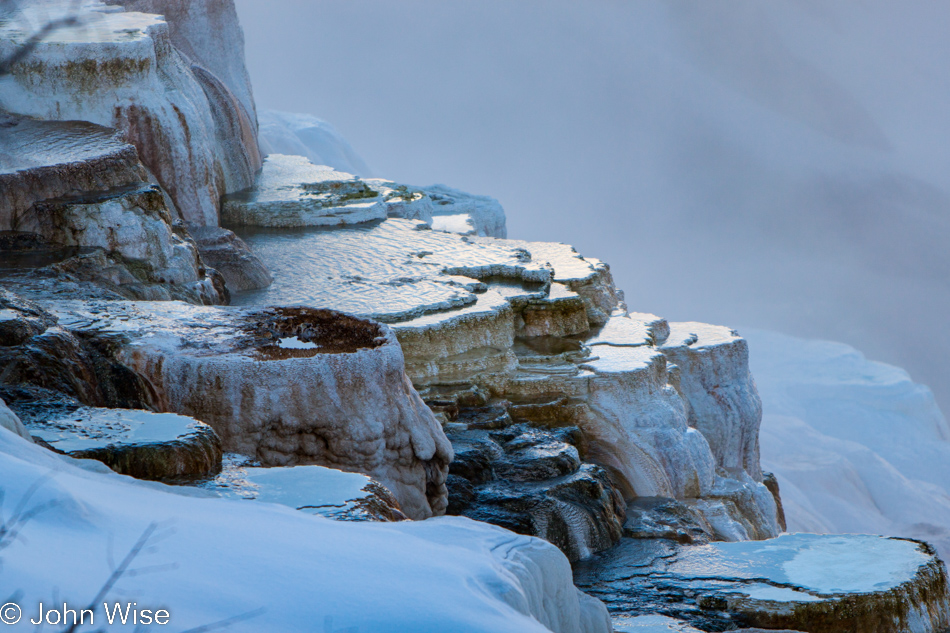
While the Buddhist may know this way of thinking and the recognition to accept the hurdles and stumbling blocks that alter our paths and those things that intrude into our expectations, it is a difficult piece of knowledge that often eludes me and is probably one source of my petty frustrations.

We revel in the beauty of the golden afternoon light as it paints the landscape anew. The cliché is alive and well that Yellowstone is never the same twice but always remains twice as spectacular as your memory will tell you it was the last time you witnessed it.

The dark of night returns early during the winter, driving us indoors. The Map Room is quiet and warm. Around the corner, a girl sells hot chocolate and espresso to further warm our cold bones. Later, after dinner, the Map Room fills with guests who watch, listen, and learn from a Park Ranger and the evening’s program. I will sit here and write until the reservation made for our nightly relaxation ritual moves us from this cozy room to the blissfully hot and steamy bubbling waters of the hot tub.












